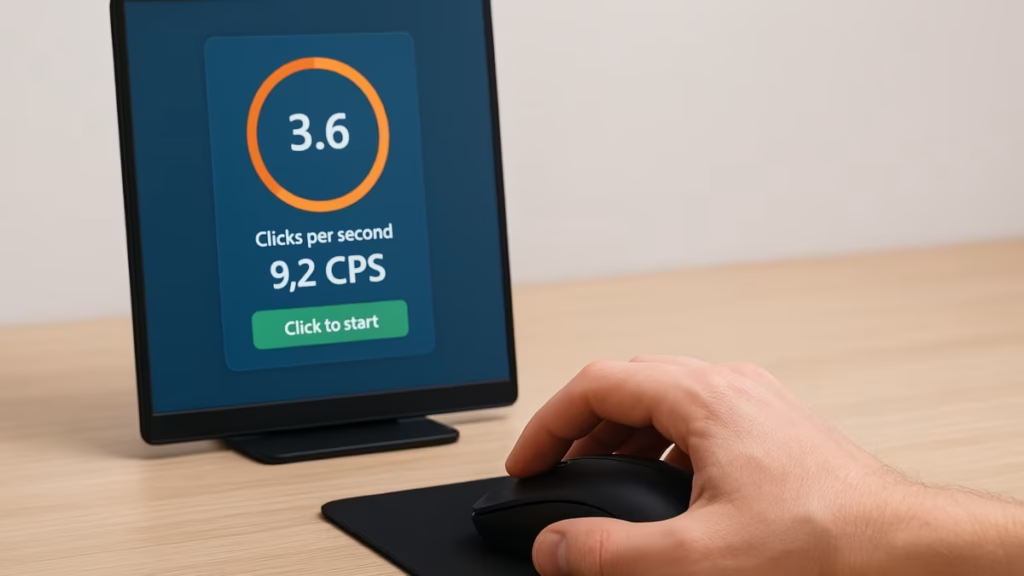Every second in gaming counts, but not every player realizes just how much can happen inside that second. The rhythm of your clicks — the rapid-fire motion of muscle and mind — can be the difference between winning and losing. CPS, or clicks per second, might sound like a minor metric, yet it represents one of the purest measures of human speed and coordination in the digital age. Whether you’re swinging a sword in Minecraft PvP, spraying bullets in a shooter, or executing rapid commands in a strategy game, CPS determines how effectively you turn intention into action.

Before reaction time became a badge of pride among players, it was a hidden skill. Those who could click faster often dominated matches without understanding why. Today, CPS has evolved into a measurable, trainable factor. Through tools like the spacebar clicker, gamers can quantify their precision and speed, tracking progress over time and building muscle memory through repetition. What begins as a simple exercise soon becomes an addictive pursuit of mastery, where the goal isn’t just speed — it’s control.
The current world record for CPS stands at an impressive 14.1 clicks per second, achieved through sheer focus, endurance, and technique. To reach such a level, the player’s hand becomes an extension of their thought process, reacting almost before the brain consciously registers movement. It’s not about frantic tapping; it’s about rhythm, timing, and consistency. Each click carries intention, and over time, trained players develop what can only be described as mechanical intuition — a flow state where precision replaces panic.
How to Improve CPS: The Role of Training and Setup
Improving your CPS requires more than just raw effort. It’s a combination of training, ergonomics, and understanding how your setup influences performance. A responsive mouse, a stable surface, and proper posture can all affect how efficiently energy transfers from your fingers to the screen.
Even factors like lighting, hand temperature, and fatigue play roles in maintaining consistent results. The real advantage comes when practice transforms from repetition into adaptation — when every session teaches your muscles to react a little faster, your eyes to anticipate movement sooner, and your nerves to stay calm under pressure.
Some players incorporate short, focused routines into their daily gaming warm-ups. Five minutes of CPS testing, grip switching, and finger dexterity drills can make a visible difference over time. It’s the same principle athletes use: repetitive motion builds muscle memory, and muscle memory builds reliability. The beauty of CPS training lies in its simplicity — no special gear, no complex mechanics, just a hand, a mouse, and determination.
Speed, however, isn’t the only benefit. Training CPS enhances neural efficiency. Every time you perform quick actions, your brain strengthens connections between sensory input and motor response. Reaction speed improves, hand-eye coordination becomes sharper, and multitasking feels more natural. What started as a curiosity — how fast can I click? — turns into a microcosm of mental discipline. The more you train, the more you learn about your limits, and the more those limits shift.
Performance testing also extends into network optimization. Many gamers underestimate how latency affects perceived speed. A fast reaction means little if your system introduces delay between input and response. Tools such as my ip tests allow players to understand their online environment, check routing stability, and ensure minimal interference during competitive play. The combination of mechanical precision and digital efficiency creates a complete foundation for peak gaming performance.
Tuning your network connection is just as crucial as training your reflexes. A player who checks my ip and verifies consistent connection paths gains a measurable advantage in fast-paced online matches. Reduced lag means clicks register exactly when intended, keeping rhythm intact and eliminating frustration from delayed input. Whether you’re building bridges in Minecraft or timing sniper shots in Counter-Strike, every millisecond reclaimed through optimization contributes to smoother control and better outcomes.
Beyond measurable numbers, there’s a deeper satisfaction in chasing progress. Watching your CPS rise from 6 to 8, from 10 to 12, sparks a small but powerful sense of achievement. It mirrors the core philosophy of gaming itself — growth through challenge. Every click represents not just a point of data but a story of persistence. You push your body to synchronize with your intent, mastering an interaction so simple yet endlessly complex.
Click training also develops patience and discipline. It teaches players to focus on rhythm rather than speed alone, to sustain accuracy under pressure, and to celebrate micro-improvements that accumulate into major gains. Over time, what starts as a curiosity becomes a ritual of self-improvement, proving that even in something as straightforward as clicking, the mind’s capacity to adapt and evolve remains extraordinary.
The real magic of CPS lies in its duality. It’s both a number on a screen and a mirror of human capability. The pursuit of faster clicks is, at its heart, a pursuit of precision, patience, and potential. When you train for speed, you’re not just improving your gameplay — you’re strengthening your connection between perception and action, thought and movement. In the world of gaming, milliseconds can define outcomes. In the pursuit of better CPS, they define progress.
Read More:

